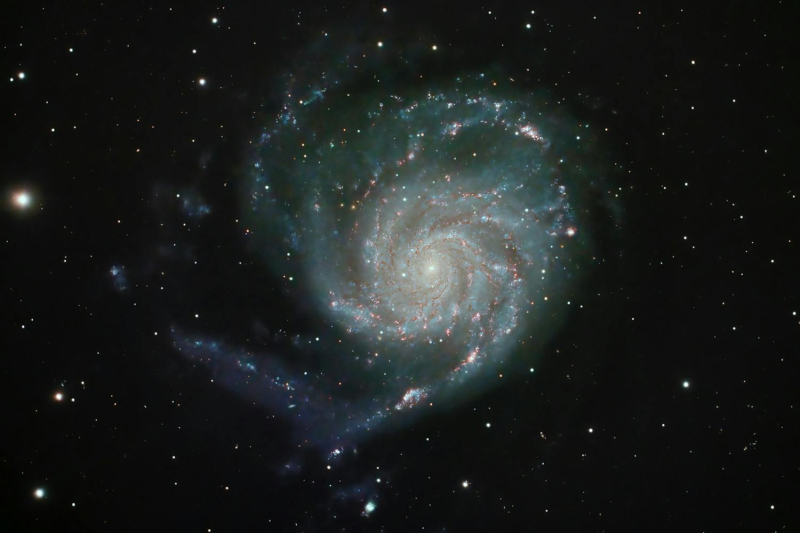
© Daniel Cid/Pexels
What is a super-Earth?? It is an exoplanet, that is, a planet located outside our solar system, whose mass is greater than that of the Earth, but less than that of a gas giant like Neptune. Scientists at the Florida Institute of Technology have simulated the profound consequences that would result if such a planet appeared between Mars and Jupiter.
Their work was published in the January issue of the journal Icarus, and show us perfectly how this theoretical celestial body would completely disrupt our solar system. To the point of making our beautiful planet completely uninhabitable under certain conditions.
A disturbance of the orbital equilibrium
The appearance of a super-Earth in the region currently occupied by the asteroid belt would cause gravitational disturbances whose magnitude would depend directly on its mass. Numerical simulations, conducted over a period of two million years, revealed two distinct scenarios with radically different consequences for our solar system.
In the first case, with a planet of moderate mass – one to two times that of Earth – the perturbations would remain manageable. Our planet would experience changes in its obliquity (the angle that its axis of rotation makes with a line perpendicular to its orbital plane), leading to more pronounced seasonal variations. Winters would become harsher and summers hotter, without compromising the fundamental conditions necessary for sustaining life. Earth's orbit would remain relatively stable, allowing essential climate cycles to be preserved.
The second scenario, involving a super-Earth with a mass ten times greater than our planet, is much more chaotic. The Earth's orbit would undergo a major destabilization within one to two million years. Our planet would be progressively pushed away from its current position, risking moving away from the habitable zone where water can exist in a liquid state. Mars would see its axis of rotation undergo drastic variations, completely disrupting its climate dynamics. Venus would not escape these perturbations, its orbit becoming more elliptical, which would intensify its already considerable thermal extremes.
How a Super-Earth Could Make Earth Uninhabitable
The effects of such a perturbation would be cataclysmic and would be on a par with the presence of a second moon, as we discussed in October. The destabilization of orbits would cause profound changes in Earth's climate cycles. Variations in the distance between Earth and the Sun would become greater,creating extreme thermal fluctuations.
200% Deposit Bonus up to €3,000 180% First Deposit Bonus up to $20,000Changing Earth's obliquity would amplify these effects, severely disrupting seasons and day-night cycles with direct consequences for ecosystems. Mass extinctions, rising oceans, extreme weather events; in short, a veritable apocalypse.
The presence of a super-Earth as massive as the one imagined in the second scenario would also disrupt the asteroid belt, potentially changing the frequency of meteorite impacts on the inner planets. This reconfiguration could expose the Earth to a sustained bombardment from celestial objects, adding an additional risk factor for the stability of the biosphere.
A Complete Reorganization of the Solar System
Apart from these localized consequences, the gravitational interactions that currently govern our solar systemwould also be completely disrupted. Our current understanding of these interactions is based on the existence of orbital resonances, configurations in which the periods of revolution of the planets have simple numerical ratios. For example, Neptune completes exactly three orbits while Pluto completes two, creating a stable celestial choreography that has been maintained for millions of years.
The considerable mass of this super-Earth would act as a new intermediate center of gravity, modifying the orbital speeds of the surrounding planets. The telluric planets, lighter and closer, would undergo the most significant perturbations. Venus, Earth and Mars would see their orbits deformed by this new gravitational force, leading to gigantic variations in their distance from the Sun and their period of revolution.
The gas giants, despite their distance and their imposing mass, would not escape the phenomenon. Jupiter, the main gravitational force after the Sun, would see its influence on the asteroid belt shared with the newcomer, creating anarchic disturbance zones. Saturn, Uranus and Neptune would experience less visible modifications to their orbits, sufficient nevertheless to gradually alter their interactions with the other bodies of the solar system.
Fortunately, all this is only theoretical, and we will never witness the occurrence of a super-Earth in our celestial neighborhood. Why ? Because our solar system, 4.6 billion years old and has had time to stabilize and cosmic events such as the arrival of a super-Earth are considered extremely rare on the scale of the life of a star. No reason to be alarmed, but this simulation is nevertheless interesting to feel the limits of our understanding of the Universe.
- The arrival of a massive super-Earth between Mars and Jupiter would have profoundly disrupted the orbits of the inner planets, making Earth potentially uninhabitable.
- Gravitational disturbances would have caused extreme climate changes, chaotic seasons, and an increase in asteroid impacts.
- Fortunately, our solar system has been stable for billions of years, and such a scenario remains purely hypothetical.
📍 To not miss any news from Presse-citron, follow us on Google News and WhatsApp.
[ ]

